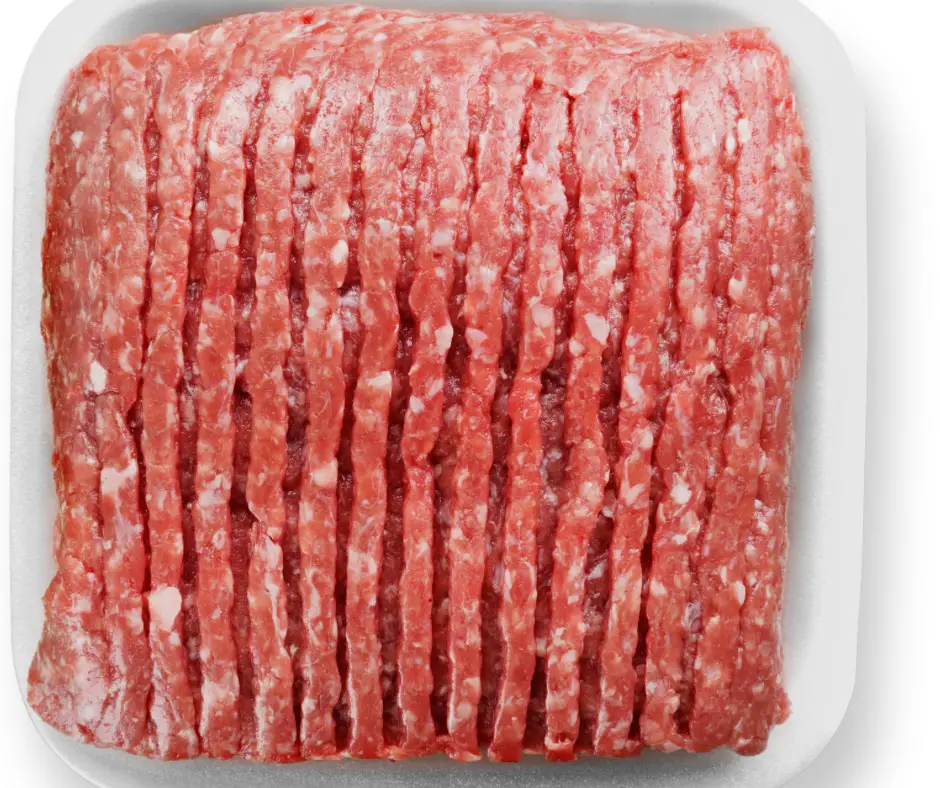Have you ever been cooking with ground beef and noticed some white strings in it?
If so, you’re not alone.
Many people are curious about what these strings are and if they are safe to eat.
In this article, you’ll learn what the white strings in ground beef are, why they happen and if they are safe to eat.

What Is The Stringy White Stuff In Ground Beef?
Insect Larva
While no one likes to think about it, some times, (although rarely), those somewhat translucent and white strings you see on your ground beef might be the larvae of insects like flies (dead or alive), or even those of parasitic worms like Beef Tapeworm. They typically make it there through improper storage where a fly eventually gets to lay its eggs on the ground beef or from an infected cattle to begin with (in the case of parasitic worms). If you do notice signs of life or inspect and discover that it wiggles and it’s a maggot, make sure to discard the meat immediately.
Silver Skin
More often than not, that white stringy material is simply ‘silver skin’, a tough collagen membrane covering some cuts of beef such as chuck roasts and round steaks. When ground up with the muscle tissue during processing, it could give rise to this stringiness in your beef.
Tendons
Another possibility is tendons – tough fibrous tissues connecting muscles to bones which can imbue the meat with a similar stringy texture. While they should ideally be removed before packaging, mishandled processing might leave traces behind in your ground beef.
Fatty Tissue
Something else that could masquerade as white strings? Fatty tissue! It can turn white when cooked or frozen and contributes to both flavor and texture. So while it changes the look of your meat a bit, it’s completely safe to consume.
Foreign Material
Lastly and least appealingly – anything foreign like plastic or bone fragments could show up looking like innocuous white strands in your package of ground beef. These are definitely not okay to consume. Promptly remove them under running water before proceeding with cooking and consider lodging a complaint where you purchased the meat from.
To Find Out What You’re Dealing With…
To determine what those white strings actually are, don’t hesitate to get hands-on!
Look at it closely and touch it- if it squirms or feels grainy, worms might be present; greasy texture points towards fatty tissue; toughness might indicate tendons or silver skin whereas hard/sharpness suggests foreign material.
Want To Avoid The Mystery?
Here’s how- always buy fresh meat from trusted sources; store it correctly in your refrigerator or freezer; cook thoroughly before consumption; check expiry dates vigilantly; inspect for signs of spoilage including mold, foul odor or sliminess.
Tapeworms In Ground Beef?
It may sound like surprise, but yes, you can find the larvae of beef tapeworms or Taenia saginata in ground beef. And these can end up in your body if you’re not careful and acts as a parasite to your system.
How Does This Happen?
The worms are typically transmitted through undercooked ground beef carrying the larvae. When these microscopic troublemakers reach into your intestines, they can multiply and mature into full-grown worms stretching up to an astounding 25 meters.
What’s The Risk?
As benign as they may seem, these unwanted parasites aren’t just unwelcome dinner guests; if untreated, they can really take a toll on your health.
Symptoms include uncomfortable abdominal pain, nausea, diarrhea, unexplained weight loss and vitamin B12 deficiency.
They’re not limited to causing discomfort; serious complications can arise such as intestinal obstruction, appendicitis, gallbladder inflammation and even cysticercosis – a condition where larvae form cysts in other organs of your body.
Diagnosis & Treatment
Tapeworm presence is confirmed by examining stools for eggs or worm segments. Once diagnosed, anti-parasitic drugs like praziquantel or niclosamide are administered to eliminate them from your system.
Preventing The Unpleasant Encounter
Prevention is always better than after-the-fact remedies when it comes to foodborne illnesses. The most effective way to avoid tapeworm-infested ground beef is simple- cook the meat thoroughly. A recommended internal temperature of 160°F (71°C) ensures any lurking parasites or bacteria are killed off.
Moreover, make sure you purchase fresh meat from reliable sources; always check expiration dates and signs of spoilage like excessive odor or slime.
Don’t compromise on hygiene either- wash hands thoroughly and disinfect any utensils or surfaces that came in contact with raw meat.
What Do Worms In Ground Beef Look Like?
Finding worms in your ground beef is a rare and rather unfortunate event.
However, understanding what these parasites look like can be crucial to ensuring the safety of the food you consume.
If the meat happens to be contaminated or spoiled, you may detect worms that appear as white stringy substances with a wiggly or grainy texture.
They may even exhibit slight movement or twitching, which can send shivers down anyone’s spine.
What Does Gristle And Femoral Artery Look Like in Ground Beef?
Gristle
Gristle, also known as elastin, is a protein found in connective tissues like silverskin and ligaments.
This component has a tough, chewy texture that remains so even after cooking.
When you see white or yellowish strings or chunks in your ground beef, you’re most likely spotting gristle.
Despite being edible, it’s best to remove gristle from the meat before cooking it.
Its rubbery consistency can be less than pleasant to chew on and could potentially compromise the overall texture of your meal.
Femoral Artery
On the other hand, femoral arteries are large blood vessels that essentially supply blood to the lower limbs of the animal.
This substantial artery runs alongside the inner thigh and through the groin region.
If present in your meat, they would appear as thick reddish tubes.
Much like gristle, while they are edible, some individuals may opt to cut it out due to personal preference or for a smoother texture in their dishes.
Why Is My Cooked Ground Beef Stringy?
Have you ever dished out your cooked ground beef only to find it has a stringy, mushy texture that just doesn’t seem right?
Chances are, one of the following factors might be responsible.
Did You Overcook It?
If you’ve left the beef on heat for a bit too long, this could cause the muscle fibers to break down and separate. This results in that undesirable stringy and mushy texture.
Quality And Type Of Cut
Using a lower quality cut with an abundance of connective tissue like sinew, ligaments or gristle can render your cooked ground beef tough and chewy.
Similarly, choosing a leaner cut with low fat content can give you drier, tougher meat.
Then there’s also the possibility of grinding an inappropriate cut like brisket or round – types of beef better suited for slow cooking or braising.
Avoiding Stringiness In Your Ground Beef:
So how do you ensure perfectly textured ground beef every time?
Here are some pointers:
Firstly, be selective about the cuts you choose for grinding.
Go for higher quality cuts like chuck or sirloin which offer more marbling contributing to tenderness.
When cooking, aim for browned and thoroughly cooked ground beef but definitely not dry or crumbly.
The recommended internal temperature is 160°F (71°C) to make sure any lurking bacteria or parasites are eliminated.
Lastly, opt for gentle cooking methods such as sautéing or baking over frying or boiling. These methods retain moisture preventing your meat from toughening up.

